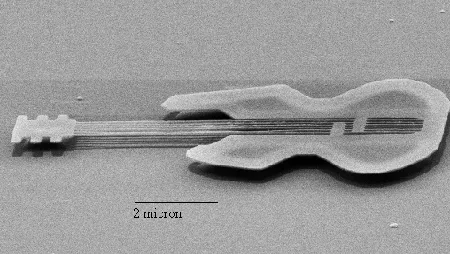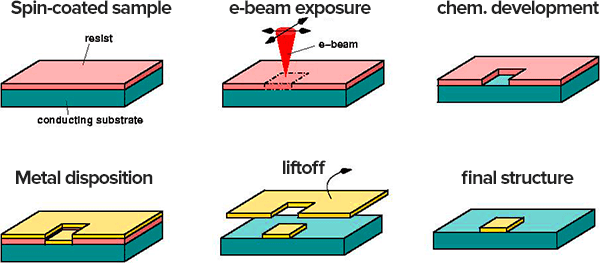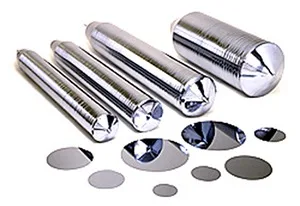We’re practically trained to think of guitars as big, shiny instruments meant to capture the eye. Sometimes, a guitar can even call more attention than the person noodling on its neck.
And while these weapons of musical extravagance do command attention when wielded upon the stage, the most attention-worthy guitar in existence may be the “nanoguitar;” a fully-functioning six-string that you can’t see without the help of a powerful microscope.

If you can’t read that, it says 2 microns. We’re talking tiny…
What is the Nanoguitar?
The nanoguitar is a tiny scientifically-driven implement designed to showcase nanotechnology; a new technology that could have a wide host of tech-based ramifications in the world of electronics, sensors, displays, and fiber optics.
Created by Cornell University researchers at the Ivy League school’s Cornell Nanofabrication Facility, the tiny axe is roughly the size of a single cell.
Made from crystalline silicon, the guitar measures 10 micrometers in length. Perhaps more impressively, it contains six strings, each of which clocks in at 50 nanometers wide. In junior high science terms, this puts each string at around 100 atoms in length.
This is so small, it would threaten to get lost within a strand of human hair. Even Eddie Van Halen would struggle to get a good hammering technique going on this little guy.
That’s Cool and All, But What’s It Sound Like?
Despite its microscopic size, the nanoguitar can technically be played. You just have to have the right equipment to do so. For instance, if you had an atomic force microscope on hand, you’d be able to pluck its strings.
With that being said, it ultimately wouldn’t do you much good. Even though the strings would resonate, you wouldn’t be able to hear anything; the sound produce would come at you via an inaudible frequency.

What a world. We know how to play the guitar, the microscopically and scientifically most advanced one in history, yet it makes no sound. That’s pretty Zen.
The Nanoguitar’s Origins
The nanoguitar is one of several teensy tiny silicon mechanical devices that Cornell researchers have built. This particular gizmo was the brainchild of two enterprising minds: Cornell professor of applied and engineering physics Harold G. Craighead and his doctoral student, Dustin W. Carr.
While the device is fun in appearance, its creation highlights some potentially important and cool applications that could emerge from devices of this size. For example…

A mechanical device this small could be helpful for applications that need small-scale mechanical probes, a high-speed response, or the measurement of ultra-tiny forces. For instance, a device made smaller than a single cell could measure various forces within a single biological molecule.
The short-term endgame of these devices when you parse the scientific dialogue is speed. The devices born from a similar silicon base as the guitar can be used to expedite fiber optic communications. According to research, the devices can make changes in a light signal’s amplitude at breakneck speed.
Craighead says they can create reflected light pulses at a rate of 12 million per second. This is a speed that could leave ethernet connections in the dust.
How are These Devices Made?
The backbone of how these tiny machines the size of the nanoguitar are made is tied to something known as electron beam lithography, also known as E-beam lithography. This is a technique used to create patterns much smaller than our range of sight; patterns that are required by the contemporary electronics industry for integrated circuits.
This technique works by scanning a beam of electrons (the e-beam) across a surface draped with a thin film, which is known as a resist. The electrons coax a chemical change in the resist, thus allowing for pattern surfacing. Once the pattern is set, you’ve got a tiny device.

This process is used to create microelectromechanical devices. In the realm of microelectromechanical materials, the devices have a minimum feature size of slightly less than 1 micrometer. It’s indeed tiny, but when we’re talking about nanotechnology, this process doesn’t result in a small enough product.
A nanometer is one-billionth of a meter. That’s small. For comparison’s sake, consider that the human hair is roughly 200,000 nanometers in diameter. Bear in mind that the strings strung on the nanoguitar only measure 50 to 100 nanometers in diameter, and you’ll have an idea of how ridiculously tiny the guitar and its pluckable strings are.
So How Did Cornell Make the Nanoguitar?
The size demands of the nanoguitar make it necessary for Craighead and Carr to deploy a special machine for its creation. Specifically, they used a machine within the Cornell Nanofabrication Facility capable of high-voltage electron beam lithography. This machine is a rare one – only two machines with this capacity exist in the U.S.
Using this machine, Craighead and Carr sculpted the nanoguitar and other structures from a solitary crystal silicon on oxide substrates. They then used a resist to create a pattern on the top layer, as they would have with an e-beam.
Finally, the oxide that’s under the layer can be painstakingly removed via a wet chemical etch. When this is completed, a structure like a teeny tiny guitar can emerge.

What’s fascinating, is that the tiny guitar could end up looking like one of Rick Nielsen’s five-neck monstrosities as this technology progresses. Craighead has stated that they can go even smaller than this. The only thing that hasn’t been figured out just yet is just how small they can get without compromising their mechanical properties and usefulness.
A Rewarded Endeavor
While the possibility of an even smaller nanoguitar may be on the horizon, Craighead and Carr will have to settle for the fact that their tiny axe has generated positive, award-winning buzz. The duo’s scan of the world’s smallest guitar has earned them awards and other various forms of recognition, including a spot in this blog (humble brag).
The ramifications that could emerge from their innovation could end up getting them a whole lot more, particularly if these devices continue to get smaller than their current, already tiny state while remaining viable for actual mechanical operations.
Until then, they have made something that people that know more about inlays and fretboards than photons can appreciate. Indeed, the mere fact that they made a workable guitar that small is remarkable. In a sense, science and technology don’t get more rock and roll than that.